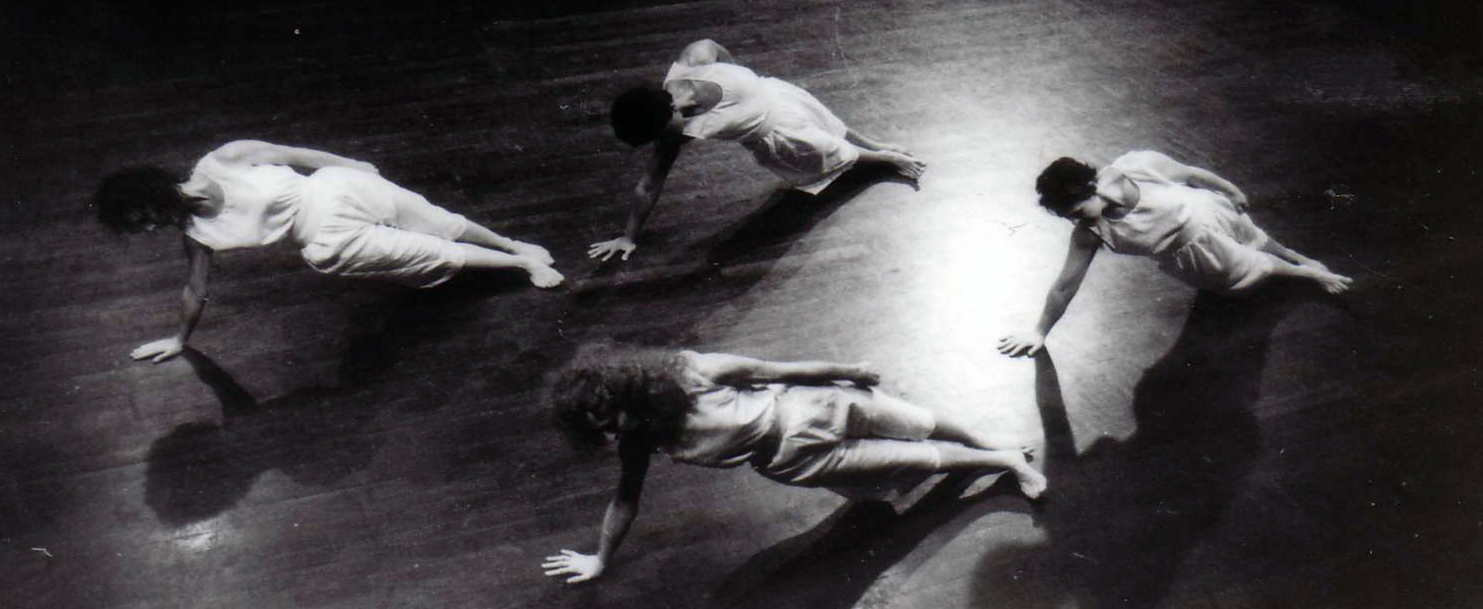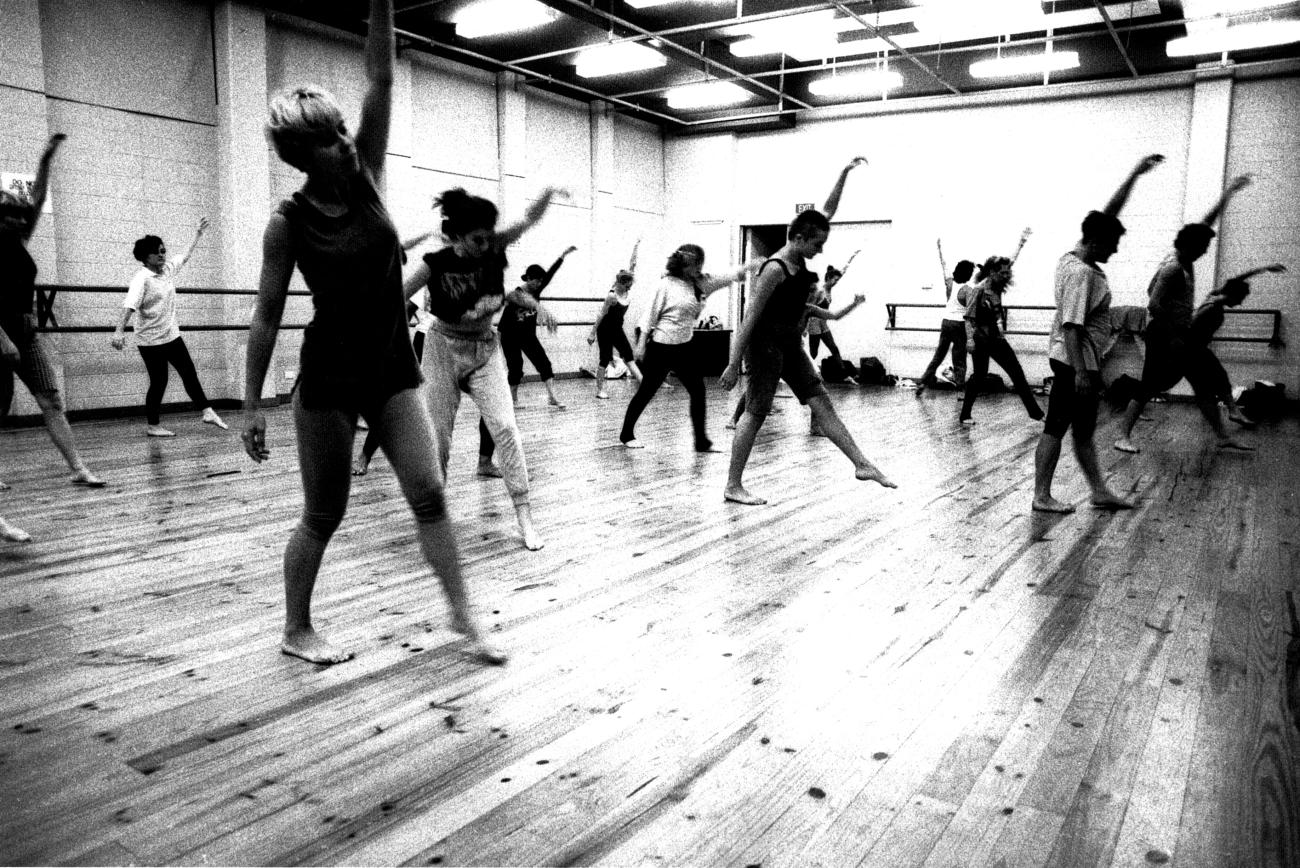1990 Community Dance Program - Brown's Mart
Text
Darwin, Jabiru, Alice Springs, Lajamanu, Northern Territory Tour
Throughout the year 1990
With Sarah Calver as the primary Community Dance Artist, the 1990 dance program expanded, continuing in its drive to provide high quality dance acitivity through the community, making it as accessible as possible to the widest variety of particpants. The model of professional dance artists and artists form other forms working with community, of taking dance to remote areas, and of creating theatrical work with strong visual and movement basis further develops in this time. It is clear in a place like the Northern Territory, where the population demographics are leaning more to Indigneous and Culturally diverse people, that work that is less English language based is very successful when engaging poeple into the activities and when making work relevent to them. Strong community Cutural development practices are still driving the work, and the reputation for working in remote commjunities and with Indigenous populations is increasing.
Program of Core Activities:
- Lajamanu Community residency 2, and tour
- Thru Moves Community Dance Performance
- Jabiru Residency
- Yipirinya School Residency - Alice Springs
- New Ways Old Ways - dance theatre with Corrugated Iron Youth Theatre
- The Older Adults (later becoming the Grey Panthers)
- Tim Newth also had a Visual Arts Research and Residency in Lajamanu
Creative Personnel
Sarah Calver: Community Dancer in Rresidence
with Tim Newth, Deb Batton, Maggi Phillips, Meredith Blackburn, Aku Kadaogo, Sophie Wendt, Natalie Wier, Claudia Barbas, Kate Holmes, Bronwyn Calcutt, Deb Humphries, Ken Hutton, Oliviere Sidore, Rob Hoad
Director's Notes - Sarah Calver
The community has accepted dance as an important part of their cultural calendar and expect it. Requests for projects are coming in, especially those communities outside Darwin. The process of servicing those requests continues to be difficult as long as there is only one office. The increase in activity is positive and I am hoping that the needs of isolated communities will become a priority.
Dance Theatre:
From 1988, working with Corrugated Iron Youth Theatre under the Direction of Janet Robertson, Sarah was encouraged to integrate dance and drama, exploring and developing existing pieces of dance theatre. In 1990, this continued under the direction of Steve Gration. Workshops through CIYT encourage social and personal awareness, confidence, trust, physical capacities and limitations of the human form, spatial awareness, technical knowledge, integration of movement into other art forms, choreographic skills, task solving, and performance preparation.
The main production under this category was New Ways Old Ways – with Corrugated Iron Youth Theatre, Darwin, Northern Territory tour, Canberra Festival.
Community Dance: Dance Mob.
4 groups. Children (5 - 12 years), teenage and adults, older adults (50+), and a youth group (18 - 24 years) based in Palmerston.
Workshops open to everyone.
Guest artists included Meredith Blackburn (Rusden State College tutor – Melbourne), Sophie Wendt (dancer) exploring techniques she had studied in Germany, Natalie Wier (Choreographer), Claudia Barbas (Folk Dancer) working with the older adults group, Kate Holmes (dancer, performer) took belly dance workshops. The dance mob performed in:
Mixtures at the Mart – Brown’s Mart Theatre Wet Season Diary, Desert Dreaming
May Day: teenage/adult group worked with Maggi Phillips and musician Bronwyn Calcutt
Easter Parade: Senior Citizens' Club
Fringe Festival: Natalie Wier choreographed a trio with three of the more experienced dancers – Fanci Hittanya, Berenice Franklin, and Frank Kraus. Maggi Phillips choreographed cabaret dance with the teenage/adult group.
Youth Ballet Performance, Darwin Performing Arts Centre, joined with Alice Springs Youth ballet. Performance of Natalie Wier’s piece.
National Arts Week: two performances, one with musician Rob Hoad, Darwin Mall. The other in Raintree Park, using material from the Thru Moves project.
Thru Moves 10 week artist residency program: Deb Batton, Aku Kadogo, Maggi Phillips, Deb Humphries (designer). Musicians, Ken Hutton, Oliviere Sidore, Rob Hoad
Residencies
Lajamanu Community Residency 2. (14 weeks: May-July, August-September, October) Sarah Calver, Tim Newth
Jabiru (7 weeks: May-June.) Guest artist, Deb Batton, who was on a six-month residency with the Community Dance program and was directing the Thru Moves project, fulfilled this residency.
Yipirinya School, Alice Springs: (April 16-20) This is a non-government community controlled Aboriginal school that caters for Indigenous students, keeping traditional Indigenous Culture and language alive. It offers two-way education, bilingual and bicultural. It teaches literacy and numeracy and western skills following the Northern Territory Curriculum, but it also teaches Indigenous languages and culture. Yipirinya School was founded on the initiative of the Indigenous Elders of the Town Camps of Alice Springs and is testimony to the fact that there are positive outcomes from these communities, despite adverse publicity.
In 1989 the Lajamanu show toured to Alice Springs and performed at this school. This led to interest in returning for a longer residency. While working towards securing the funding for this in the future, Tim Newth and Sarah Calver had a one-week residency in this school. The workshops utilised the thematic material being taught through the classes, in both traditional and western methods. For example, Lower Primary were learning about fire, and grades 6 and 7 were involved in nature and the environment.
We returned to the school in May with Corrugated Iron Youth Theatre’s show New Ways Old Ways, and again with the Lajamanu Residency Touring Show. The regular contact over this year has made the staff more determined to have a residency of their own.
Schools
In service: Deb Batton ran a five-week course in contemporary dance teaching for Primary Teachers
Kormilda College: Workshops by Aku Kadogo. Also music workshops run by musicians in residence Ken Hutton an Oliviere Sidore
Casuarina College: Maggi Phillips taught year 11 and 12 modern dance students
Palmerston Ballet School
Nungalinya College Cross Cultural Course: 5 day course introducing people to aspects of working with Aboriginal culture. It emphasized the need for “time” to deal properly with the relevant issues.
One off classes were also a part of Territory tours: Yirrkala School, Gove Primary School, Groote Eylandt Area School, Jabiru Area School, Beswick School, Lajamanu School, Yipirinya School, Alice Springs Youth Theater.
Darwin Theatre Winter School: Sarah attended workshops by Annette Downs looking at voice and movement for actors
Melbourne Professional Development Trip: (November) Sarah went to perform with artist Debra Batton in a dancers’ Fete organized by Danceworks, but unfortunately this was postponed. She met with many dance artists regarding future projects in Darwin (including David McMicken, who was then Artistic Director of Storm In A Teacup Dance Theatre).
New Zealand Choreographic Course: (December)
Sarah was accepted into this course, which had a focus on cross-cultural work. “On arriving in New Zealand the flow of things to come became apparent. The introduction to Maori culture was different and refreshing. At times the language was a definite barrier and I would have liked an insight into what was being said around me. But having gone through a lot of that in Aboriginal communities it did not alienate me totally, it merely emphasized English as a second language.
The participants were from quite different backgrounds and very wide expectations. We did get a taste for many different styles and cultures, and the workshops stimulated and inspired people. However, the emphasis on the end product of the course caused many reactions. The word “collaboration” had many meanings to different people and the issues confronting Indigenous groups were more relevant to them than that of collaboration – how could they collaborate when basic issues weren’t being acknowledged or understood? The many discussions that followed brought us closer together as a group, but were emotionally draining and took away most of the creative time, and urges … people’s eyes were opened to new levels of understanding achieved. City people gained insights into community living and vice versa. Cross cultural work is not easy and this course demonstrated that patience, sensitivity, and the ability to listen and look are vital; overcoming one’s ignorance on cultural differences makes for a more positive union.”
This was a year of traveling from place to place with little time in between. From the extremes of the desert, to the big city of Melbourne. The shock of the city and all it unfolds after the bareness of the desert – I don’t think many people could relate to “culture shock”.
The Northern Territory is North of the Border, and South of the Sea, and is a part of Australia. The lack of recognition and awareness of local arts-based activities in the Top End is a shame. There is a lot happening up here, especially in the community dance and dance-theatre area, and there is a lot of energy and room for growth. While other states may have continuous access to companies and dance artists, projects and development, courses and flow of ideas, it is sad that there is not at least one professional dance company in existence in the Northern Territory that can reach people in the Outback as well as the other towns spread throughout.
People in the Northern Territory are expressing their interest and support in dance and yet it is a never-ending battle to expand the existing program to the wider Northern Territory population. Although I reap the benefits of the variety open to me in the Top End, it is also hard to “top up”.
With increasing contact into Indigenous communities, amazing and unique talent is being unearthed. There is a great need for a training school (like National Aboriginal Islander Skills Development NAISDA), as the Indigenous population of the Northern Territory outweighs that of other parts of Australia. There is a growing interest in the Lajamanu style residencies, but attracting appropriate artists from down south is a difficult task, especially on any long-term basis that is essential for success for both the community people, and the artists involved.
There is ongoing tension b etween the needs of the community and the capacity for outside artists to commit the time needed for full development. Although artists like Debra Batton had a very positive time and experience here, they also have lives in other places and cannot commit to being fully here. Other artists appear almost afraid to “tread new ground” or be away form the city for any length of time to go somewhere “so far away”. The focus is now on raising the profile of Northern Territory dance activities and raise the awareness of the direction dance is taking here. The Northern Territory is not just Darwin and Alice Springs, there is much in between and beyond, and I would like to see dance reaching out more in the future.
1990
Dance Development Office: Sarah Calver
[Under Brown’s Mart Community Arts – Executive Officer Ken Conway]
Videos
Explore Further
Background
This is the third year of the Dancer-In-Community position at Brown’s Mart, held by Sarah Calver. The three main areas of focus are, Community Dance, Dance Theatre, and Residencies – especially Indigenous and cross cultural projects.


